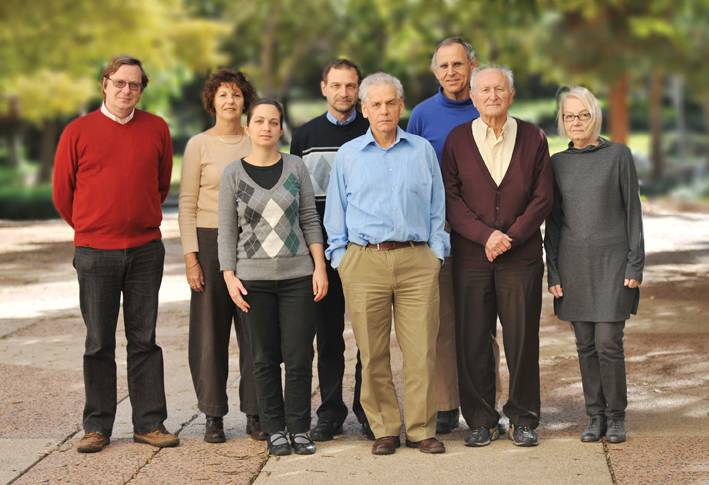Solar radiation, considered an infinite source of energy, can also provide a rare glimpse into the world of nanomaterials.

Solar radiation, considered an infinite source of energy, can also provide a rare glimpse into the world of nanomaterials. In a new study, carried out by scientists from the Weizmann Institute of Science and Ben-Gurion University of the Negev, the shape of certain inorganic nanoparticles was discovered through the use of concentrated sunlight. The research, in which German scientists also participated, "sheds sunlight" on the behavior of nanometer-sized particles, and may lead to the development of advanced applications of various nanomaterials.
Nearly two decades ago, Prof. Rashef Tana and his research partners in the Faculty of Chemistry at the Weizmann Institute discovered for the first time that nanoparticles of an inorganic material can form hollow cage-like structures. Until then, it was believed that only carbon molecules could create hollow, spherical structures - structures that were nicknamed "fullerenes" due to their resemblance to the geodesic domes invented by the architect Richard Beckminster Fuller. Prof. Tana's discovery opened a new field of research, focusing on fullerene-like inorganic particles, which led to surprising applications - such as the production of improved solid lubricants. However, research in the field has opened up many new questions, especially those relating to the relationship between the special properties of the particles and their structure and shape.
The so-called "true" inorganic fullerene particle - that is, the smallest and most stable cage-like particle of an inorganic material - has an octagonal structure: a body resembling a cube, but with eight faces instead of six. Scientists at the Weizmann Institute and other research institutes around the world have already created such octagons before, but larger inorganic fullerenes have a multi-layered spherical structure. How is the shape of the nanoparticle determined?
The answer to this fundamental question, which is central to understanding nanomaterials, was obtained in the new study, which was recently published in the international edition of the journal Angewandte Chemie. The international team of researchers worked with nanoparticles whose size does not exceed several millionths of a meter, of a substance called molybdenum disulfide (MoS2).
The first goal was to create atomic vapors of molybdenum disulfide. In the studies carried out in the past, in which laser light was used for this purpose, only small octagons were formed, made of about 20,000 atoms. In order to create larger octagons, the scientists from Ben-Gurion University, led by Prof. Jeffrey Gordon, built an innovative solar device consisting of a system of mirrors that concentrates the sun's rays, producing an extremely intense beam, the power of which is approximately 15,000 times stronger than the sun's rays. The scientists used this device to heat molybdenum disulfide to a temperature of 2,500 degrees Celsius, turning it into a hot cloud of individual atoms. Since the concentrated solar beam is much wider than the lasers used in previous studies, unique conditions were created in the device. These conditions allowed the cooling atoms to form clusters much larger than those created following the use of the laser.
Afterwards, Dr. Anna Albo-Yiron from the Weizmann Institute and her colleagues used several electron microscopes - including the advanced microscope in Dr. Lothar Hoben's laboratory at the Yulich Research Center in Germany - to examine the structure of the nanoparticles that were created. The resulting images provided the first experimental proof of the theoretical predictions produced by Prof. Gotthard Seifert's group at the Technical University of Dresden, which turned out to be remarkably accurate. The images revealed that in addition to multi-layered octagons and spheres, "hybrid" intermediate particles are also sometimes formed.
It turns out that there is a relationship between the resulting structure and the size of the particle: the smallest molecules, less than 100,000 atoms in size, were hollow octagons. Larger particles, comprising about 500,000 atoms, had an intermediate structure: octagonal layers at the core, which are wrapped in many spherical layers, like an onion.
Besides the answers they offer to basic questions in the field of materials science, the research results may lead to practical applications. Molybdenum disulfide is used as a catalyst in the cleaning process of fossil fuels. In this process, the sulfur is eliminated in order to prevent the formation of sulfur dioxide, which contributes to acid rain. For this purpose, the nanoparticle form of molybdenum disulfide may be much more effective: thanks to their three-dimensional structure, these particles may be more accessible to reactions with the sulfur, thus speeding up the cleaning process. When they succeed in producing them in sufficient quantities, the scientists intend to test the potential of the solar particles as catalysts for sulfur removal. Such catalysts will benefit the environment in two ways: they will be produced using a clean solar method, and will be more effective in reducing the damage caused by fossil fuels to the environment.
Other possible applications for solar nanoparticles are related to the fact that the octagonal molecules of molybdenum disulfide have the properties of a metal, but the spherical particles are semiconductors. This means that the particles with the octagonal-spherical intermediate structure are semiconductors surrounding a component with metallic properties. Such a structure may have new uses in the semiconductor industry, such as, for example, creating advanced sensors.
The research was carried out by Dr. Anna Albo-Yiron and Prof. Moshe Levy in the laboratory of Prof. Rashef Tana, from the Department of Materials and Surfaces in the Faculty of Chemistry at the Weizmann Institute of Science, with Dr. Ronit Popovich-Biro from the Department of Chemical Services at the Institute; together with Prof. Daniel Feuerman and Dr. Eugene Katz from the laboratory of Prof. Jeffrey Gordon at Ben-Gurion University; And in collaboration with scientists from Germany: Mark Weidenbach, Dr. Maya Bar-Sedan, and Dr. Lothar Houben at the Yulich Research Center, and Dr. Andrey Anyashin and Prof. Gotthard Seifert from the Technical University of Dresden.
